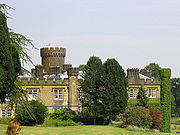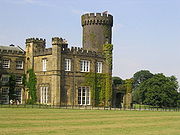
Swinton Park
Encyclopedia

English country house
The English country house is a large house or mansion in the English countryside. Such houses were often owned by individuals who also owned a London house. This allowed to them to spend time in the country and in the city—hence, for these people, the term distinguished between town and country...
in Swinton near Masham
Masham
Masham is a small market town and civil parish in the Harrogate district of North Yorkshire, England. It has a population of 1,235. Situated in Wensleydale on the western bank of the River Ure, the name derives from the Anglo-Saxon "Mæssa's Ham", the homestead belonging to Mæssa. The Romans had...
, North Yorkshire
North Yorkshire
North Yorkshire is a non-metropolitan or shire county located in the Yorkshire and the Humber region of England, and a ceremonial county primarily in that region but partly in North East England. Created in 1974 by the Local Government Act 1972 it covers an area of , making it the largest...
, England
England
England is a country that is part of the United Kingdom. It shares land borders with Scotland to the north and Wales to the west; the Irish Sea is to the north west, the Celtic Sea to the south west, with the North Sea to the east and the English Channel to the south separating it from continental...
. It is set in 200 acre (0.809372 km²) of parkland, lakes and gardens. Currently operating as a 30-bedroom hotel, it is surrounded by the family estate in which guests have access to rivers, reservoirs, moorland, dales, and beautiful countryside bordering the Yorkshire Dales National Park.
History
The construction at Swinton Park was commenced in 1695 by Sir Abstrupus DanbyAbstrupus Danby
Sir Abstrupus Danby was an English wool merchant and country gentleman. He was the son of Christopher Danby and Anne Culpepper, niece of Lord Colepeper....
. His successors built the stable block and gatehouse and, during the 1760s, planted the parkland and created the chain of five lakes.
William Danby
William Danby
William Danby was an English writer who rebuilt his family home of Swinton Park, North Yorkshire in Gothick taste and recreated Stonehenge on considerable scale in his park, as the "Druids' Temple"....
almost entirely rebuilt the house, at first by John Carr, architect of York, in 1764-67. Danby altered and extended the house, giving it the Gothic aspect it retains, in two building campaigns, to designs of the Yorkshire mason-architect John Foss of Richmond ((1745–1827)., who became a close personal friend. In the first, of 1791-96, the north range was added. A design for the Drawing Room, at least, was contributed by James Wyatt
James Wyatt
James Wyatt RA , was an English architect, a rival of Robert Adam in the neoclassical style, who far outdid Adam in his work in the neo-Gothic style.-Early classical career:...
. In a second building campaign, of 1813-14, again under the direction of Foss, the south wing was built. The house included a handsome library.

Robert Lugar
Robert Lugar , was an English architect and engineer in the Industrial Revolution.Although born in Colchester, England, Lugar carried out much of his most important work in Scotland and Wales, where he was employed by several leading industrialists to design grand houses such as Balloch Castle and...
: turrets and battlements were added, so that the building took on the appearance of a castle
Castle
A castle is a type of fortified structure built in Europe and the Middle East during the Middle Ages by European nobility. Scholars debate the scope of the word castle, but usually consider it to be the private fortified residence of a lord or noble...
; the richly furnished museum of minerals, which has since become a family chapel, was built, and at the same time a tower Describing a tour which he made in 1829, the poet Robert Southey
Robert Southey
Robert Southey was an English poet of the Romantic school, one of the so-called "Lake Poets", and Poet Laureate for 30 years from 1813 to his death in 1843...
remarked, "The most interesting person whom I saw during this expedition was Mr. Danby of Swinton Park, a man of very large fortune, and now very old." During the early 19th century the building was substantially altered, and two story west and north wings were added.
Gardens and park
The earliest record of the gardens dates from 1699 when a design by George LondonGeorge London (landscape architect)
George London was an English nurseryman and garden designer. He aspired to the baroque style and worked on the gardens at Hampton Court, Melbourne Hall and Wimpole Hall....
was laid out, with fountains added a few years later. A model for a summer house by the carpenter and architect William Thornton was approved by Sir Abstrupus in 1700. This formal plan was swept away, probably by William Danby during his landscaping programme in the 1760s that resulted in the present English landscape garden. In the next years five lakes were dug out. During a time of agricultural depression and high unemployment, Danby hired local men to construct a moderately large-scale replica of Stonehenge
Stonehenge
Stonehenge is a prehistoric monument located in the English county of Wiltshire, about west of Amesbury and north of Salisbury. One of the most famous sites in the world, Stonehenge is composed of a circular setting of large standing stones set within earthworks...
on a moor near Ilton, as a "Druid
Druid
A druid was a member of the priestly class in Britain, Ireland, and Gaul, and possibly other parts of Celtic western Europe, during the Iron Age....
s' Temple", working at a full shilling a day. The result is a folly
Folly
In architecture, a folly is a building constructed primarily for decoration, but either suggesting by its appearance some other purpose, or merely so extravagant that it transcends the normal range of garden ornaments or other class of building to which it belongs...
of national reputation. He was less successful in hiring a silent druidic hermit to fulfill a seven-year contract, though several tried, for the promised annuity. The Gothick alterations were accompanied by the Quarry Gill Bridge completed in 1822, also to designs by Foster. During the 1880s a stone bridge was built at Coffin Pond. The parkland supports a herd of approximately 100 fallow deer.
The castle was bought in 1882 by Samuel Cunliffe-Lister, who added a third floor and enlarged the dining room. Samuel's granddaughter Molly and her husband Philip came to live at Swinton in 1924 and took the name of Cunliffe-Lister. Philip was created Viscount Swinton in 1935 and the 1st Earl of Swinton
Earl of Swinton
Earl of Swinton is a title in the Peerage of the United Kingdom. It was created in 1955 for the prominent Conservative politician Philip Cunliffe-Lister, 1st Viscount Swinton. He had already been created Viscount Swinton, of Masham in the County of York, in 1935, and was made Baron Masham, of...
in 1955. During World War II
World War II
World War II, or the Second World War , was a global conflict lasting from 1939 to 1945, involving most of the world's nations—including all of the great powers—eventually forming two opposing military alliances: the Allies and the Axis...
Harrogate Ladies College occupied part of the premises. In 1974 Molly Cunliffe-Lister died, and the castellated house was sold in 1980.
From 1976 to 1998, the castle was occupied by the Lindley Educational Trust. Mark Cunliffe-Lister, the great-grandson of Molly, along with his mother, brother and sister, bought back the castle in May 2000. On 17 June 2000 Mark and Felicity (styled by courtesy as Lord and Lady Masham) married. After their honeymoon they moved to Swinton and set up the family business here. The 30 bedroom luxury castle hotel was opened in 2001, having undergone extensive refurbishment.
Currently Swinton Park is the highest rated hotel in Yorkshire and Cumbria; it has been awarded four Red Stars and three Rosettes by the AA for excellent facilities.

